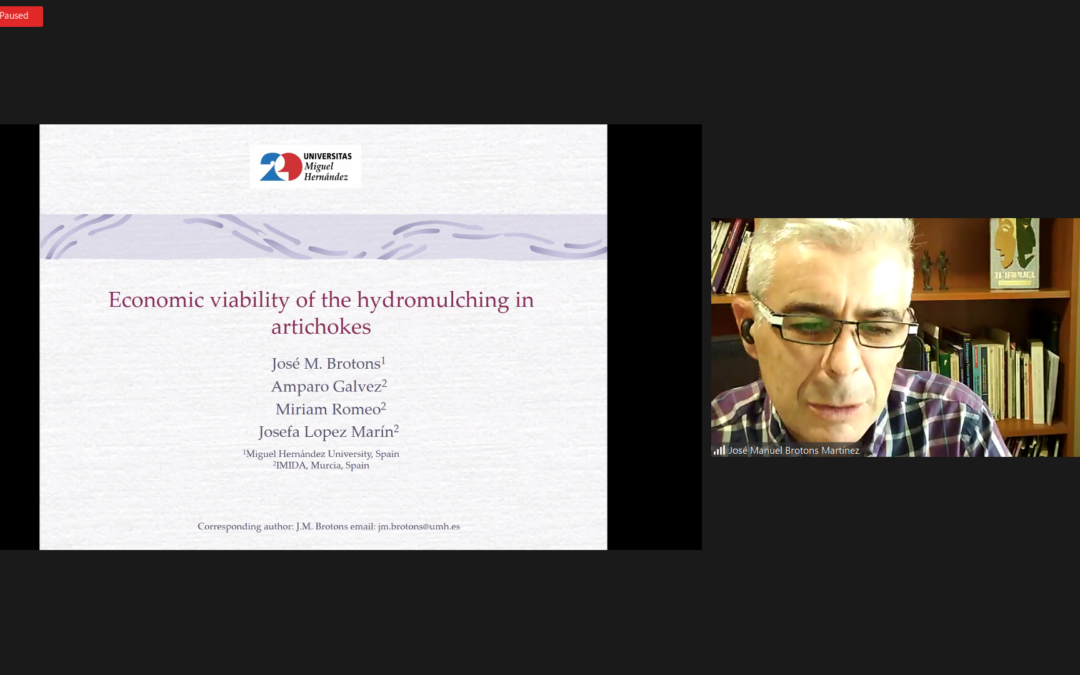José Manuel Brotons-Martínez – Department of Economic a Financial Studies, Universidad Miguel Hernández, Elche, Spain
Amparo Galvez – Department of Crop Production and Agri-technology. IMIDA. Murcia, Spain
Miriam Romero – Department of Crop Production and Agri-technology. IMIDA. Murcia, Spain
Josefa Lopez-Marín – Department of Crop Production and Agri-technology. IMIDA. Murcia, Spain
DOI: https://doi.org/10.31410/ITEMA.2021.183
5th International Scientific Conference on Recent Advances in Information Technology, Tourism, Economics, Management and Agriculture – ITEMA 2021, Online/virtual, October 21, 2021, CONFERENCE PROCEEDINGS published by the Association of Economists and Managers of the Balkans, Belgrade; Printed by: SKRIPTA International, Belgrade, ISBN 978-86-80194-51-6, ISSN 2683-5991, DOI: https://doi.org/10.31410/ITEMA.2021
Abstract
Although its utility, excessive use of low-density polyethylene mulches is contributing to the accumulation of high amounts of plastic wastes and environmental problems for agricultural ecosystems. The objective of this work was to study the economic viability of the use of different hydromulches in an artichoke crop. Three blends were prepared by mixing paper pulp and cardboard with different additives: wheat straw (WS), rice hulls (RH), and substrate used for mushroom cultivation (MS). These were compared with low-density polyethylene (Pe), a treatment without mulching on bare soil where hand weeding was performed (HW), and treatment without mulching on bare soil where herbicide was applied (H). The results indicate that the use of hydromulch in an artichoke crop represents a good alternative for reducing plastic waste in agriculture. The net profits of the hydromulch treatments (MS, WS, RH) were higher than for HW and H, and slightly lower than for Pe.
Keywords
Eco-friendly; Microplastic; Mulch; Weed control
References
CARM. 2021. Consejería de Agricultura de la Región de Murcia. Disponible en https://caamext. carm.es/esamweb/faces/vista/seleccionPrecios.
Chakraborty, D., Nagarajan, S., Aggarwal, P., Gupta, V.K., Tomar, R.K., Garg, R.N., Sahoo, R.N., Sarkar, A., Chopra, U.K., Sarma, K.S.S. & Kalra, N. (2008). Effect of mulching on soil and plant water status, and the growth and yield of wheat (Triticum aestivum L.) in a semi-arid environment. Agric. Water Manag. 95, 1323–1334.
Chakraborty, R.C. & Sadhu, M.K. (1994). Effect of mulch type and color on growth and yield of tomato (Lycopersicon esculentum). Indian J. Agric. Sci. 64, 608–612.
Chantigny, M.H. (2003). Dissolved and water-extractable organic matter in soils: a review on the influence of land use and management practices. Geoderma, 113, 357–380.
FAOSTAT. 2021. https://www.fao.org/faostat/en/#search/Artichokes. 25/10/2021
Huang, Z., Xu, Z., Chen, C. (2008). Effect of mulching on labile soil organic matter pools, microbial community functional diversity and nitrogen transformations in two hardwood plantations of subtropical Australia. Appl. Soil Ecol., 40, 229– 239.
Kader, M. A., Senge, M., Mojid, M. A. & Ito, K. (2017). Recent advances in mulching materials and methods for modifying soil environment. Soil and Tillage Research, 168, 155–166. https://doi.org/1 519 0.1016/j.still.2017.01.001
Kannan, R. (2020). Chapter-1 uses of mulching in agriculture: a review. Current Research in Soil Fertility, 1. Delhi: AkiNik Publications.
López-Marín, L., González, A. Fernández, J.A., Pablos, J.L. & Abrusci, C. (2012). Biodegradable mulch film in a broccoli production system. Acta Hort (ISHS). 933, 439-444.
Prestamburgo, M. & Saccomandi, V. (1995). Economia agraria. Milano: Etas libri Mondadori.
Romero, M., Gálvez, A., Del Amor, F. & López-Marín, J. (2019). Evaluación preliminar del comportamiento agronómico de un cultivo de alcachofa con hidromulch. In C. A. Sánchez-Manzanera, Y. S. Calvo, R. V. Izquierdo, J. J. M. Mínguez, I. L. García, & C. B. Soria (Eds.), Actas de horticultura 83, 152-156. Sociedad Española de Ciencias Hortícolas.
Scalenghe. (2018). Resource or waste? A perspective of plastics degradation in soil with a focus on end-of-life options, Heliyon, 4, 12. https://doi.org/10.1016/j.heliyon.2018.e00941.
Steinmetz, Z., Wollmann, C., Schaefer, M., Buchmann, C., David, J., Tröger, J., Muñoz, K., Frör, O., & Schaumann, G. E. (2016). Plastic mulching in agriculture. Trading short-term agronomic benefits for long-term soil degradation. Science of the Total Environment, 550, 690–705. https://doi.org/10.1016/j.scitotenv.2016.01.153
USDA. (2021). Artichoke, raw (SURVEY) (FNDDS), 1103334. 26/09/2021. https://fdc.nal.usda. gov/fdc-app.html#/food-details/1103334/nutrients
Warnick, J.P., Chase, C. A., Rosskopf, E.N., Simonne, E.H., Scholberg, J.M., Koenig, R.L. et al. (2006). Weed suppression with hydramulch, a biodegradable liquid paper mulch in development. Renew Agr Food Syst., 21, 216-223.
Zhao, H., Wang, R.Y., Ma, B.L., Xiong, Y.C., Qiang, S.C. & Wang, C.L. (2014). Ridge-furrow with full plastic film mulching improves water use efficiency and tuber yields of potato in a semiarid rainfed ecosystem. F. Crop. Res. 161, 137–148.





